5 reasons parents worry about crowded teeth
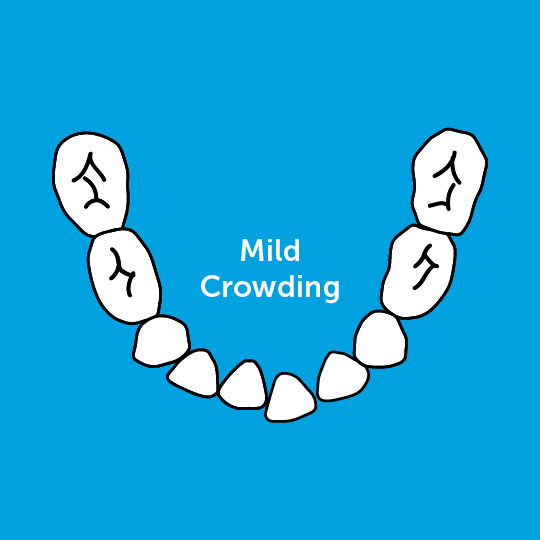
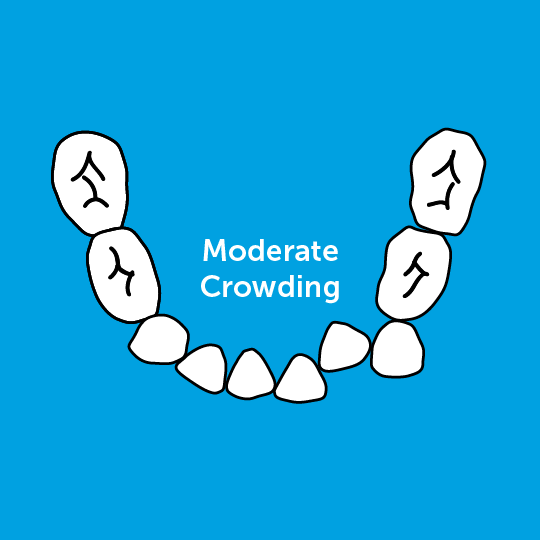
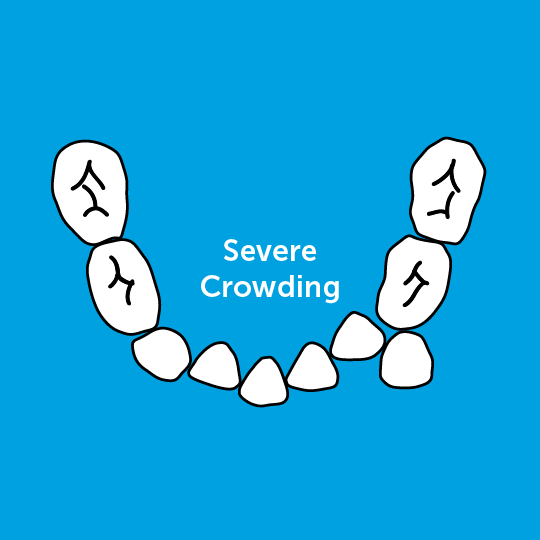
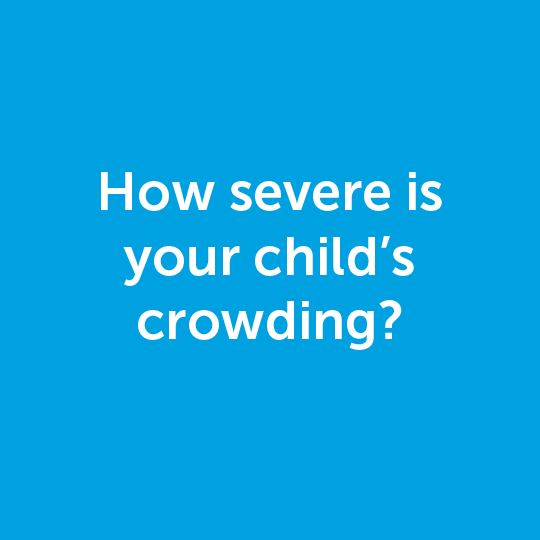
1. Mild vs. moderate vs. severe crowding
If you are like most parents, you are hoping that any crowding you see in your child’s mouth is mild.
But is it already severe?
(Or is it totally fine?)
Match the illustrations below with your child’s teeth to find out now.
(Parents in South Brunswick, NJ who are concerned about their child’s crowding will want to visit us for a complimentary consultation.)
The next trouble with crowding is stuck teeth …
2. Stuck teeth
When kids see an X-ray of an impacted tooth, they tell us that it looks “stuck”.
And they are right!
What kids don’t know is that their stuck teeth can cause problems with jaw pain and damage the surrounding teeth.
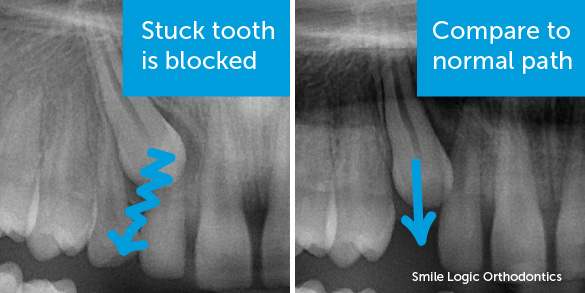
An adult front tooth is blocked from coming in. Note that the stuck tooth overlaps and damages the neighboring adult tooth.
So if one tooth is stuck, it’s probably going to affect the tooth beside it, too.
That’s a problem because the adult teeth naturally erupt in a particular sequence and at certain ages.
And impacted teeth interfere with nature.
A note on impacted teeth
The main risk of a "stuck" tooth is that the tooth will torpedo sideways into a neighboring tooth and weaken the roots of the neighboring teeth.
So instead of a problem of one "stuck" tooth, you end up with a stuck tooth and having to remove the weakened adult teeth on either side.
That means there would be gaps where teeth are missing.
The most common reason for stuck teeth is that there is some physical barrier that is blocking it from coming in.
That “road block” could be a traffic jam of teeth caused by crowding. Or it could be an extra tooth in the way. Or it could be because of a strong baby tooth that won’t wiggle loose.
(We wouldn’t know until we study an X-ray.)
The next trouble with crowding is blocked out teeth …
3. Blocked out teeth
Even if crowded teeth avoid impaction, letting them come in the wrong place can have lifelong consequences.
A tooth becomes “blocked out” when it is crowded out of position.
Here’s an example:
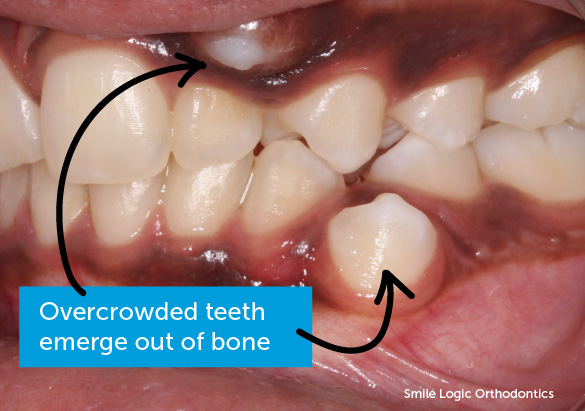
Adult teeth that don't have room to fit come in out of place.
So instead of the tooth lining up with the rest, the deflection causes the tooth to appear like it is poking out towards lips and cheeks or falling inwards towards the tongue.
The problem with that is that there isn’t enough gum to hold the blocked out tooth.
Plus it lacks support from the U-shaped bone of the jaws.
In severe cases, the lack of bone support can lead to the loosening and loss of the adult tooth.
A note on gingival recession
You have probably seen gingival recession before.
It's when the gum erodes away, and the sensitive root of the tooth gets exposed.
They make special toothpaste to help with the sensitivity, and there are special surgical procedures that help, but it's better if recession can be avoided altogether.
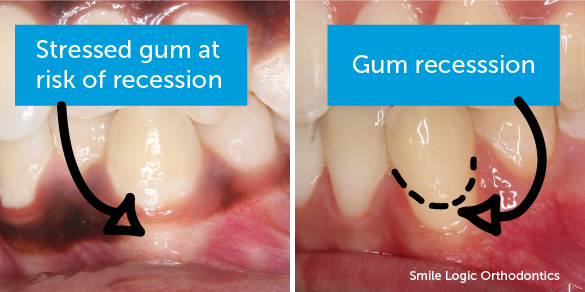
Gum recession happens when the tooth is not supported by the bone.
The next trouble with crowding is “bad” teeth …
4. "Bad" teeth
Most parents want their child to have a nice smile.
Crowded teeth can get in the way of that by making the teeth look jumbled.
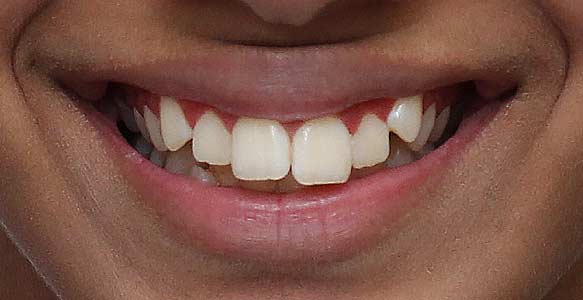
Crowded teeth interfere with a nice smile.
If you are like most parents, the health problems (e.g. stuck teeth, blocked out teeth, gum disease, etc.) are enough of a reason for most parents to get crowding checked.
The socially advantageous benefits of straighter teeth are just a bonus.
And enhancing appearance of the teeth is worth talking about because it can affect your child’s academics, social relationships, and career:
Greater academic potential. (Ritts,V., Patterson, M. L., & Tubbs, M. E. (1992). Expectations, impressions, and judgments of physically attractive students: A review. Review of Educational Research, 62, 413–426.)
More persuasive communicators. (Chaiken, S. (1979). Communicator physical attractiveness and persuasion. Journal of Personality and Social Psychology, 37, 1387–1397.)
More likely to receive help from strangers. (Benson, P. L., Karabenick, S. A., & Lerner, R. M. (1976). Pretty pleases: The effects of physical attractiveness, race, and sex on receiving help. Journal of Experimental Social Psychology, 12, 409–415.)
More lenient punishment if found guilty of a crime. (Mazzella, R., & Feingold, A. (1994). The effects of physical attractiveness, race, socioeconomic status and gender of defendants and victims on judgments of mock jurors: A meta-analysis. Journal of Applied Social Psychology, 24, 1315–1344.)
More socially competent. (Eagly, A. H., Ashmore, R. D., Makhijani, M. G., & Longo, L. C. (1991). A meta-analytic review of research on the physical attractiveness stereotype. Psychological Bulletin, 110, 109–128.)
Preferred by voters in political elections. (Budesheim, T. L., & DePaola, S. J. (1994). Beauty or the beast? The effects of appearance, personality, and issue information on evaluations of political candidates. Personality and Social Psychology Bulletin, 20, 339–348.)
More likely to be hired. (Hosoda, M., Stone-Romero, E. F., & Coats, G. (2003). The effects of physical attractiveness on job-related outcomes: A meta-analysis of experimental studies. Personnel Psychology, 56, 431–462.)
More likely to be promoted. (Hosoda, M., Stone-Romero, E. F., & Coats, G. (2003). The effects of physical attractiveness on job-related outcomes: A meta-analysis of experimental studies. Personnel Psychology, 56, 431–462.)
Better performance evaluations. (Hosoda, M., Stone-Romero, E. F., & Coats, G. (2003). The effects of physical attractiveness on job-related outcomes: A meta-analysis of experimental studies. Personnel Psychology, 56, 431–462.)
Receive higher incomes. (Frieze, I. H., Olson, J. E., & Russell, J. (1991). Attractiveness and income for men and women in management. Journal of Applied Social Psychology, 21, 1039–1057. Hamermesh, D. S., & Biddle, J. E. (1994). Beauty and the labor market. American Economic Review, 84, 1174–1194.)
Even “bad” teeth have the potential to straighten into a nice smile with a little help.
And that brings us to the last trouble parents have with crowding: finding out if your child needs braces …
5. Braces
If you are like most parents, you want to get a checkup for your child’s crowding, but you have questions about braces.

Get your child's smile back on the path towards a lifetime of health at Smile Logic Orthodontics in South Brunswick, NJ.
When we meet for your complimentary braces consultation, I will gently walk through all your concerns and take the time to help plan an affordable path forward.
I can tell you if your child needs braces, how long they’ll have to wear them, and exactly what the investment would be if they are needed.
For any portion of treatment your insurance doesn’t cover, there is zero-interest, in-house financing available.
If you’re ready to know for sure if your child will need braces or not go ahead and call 732-274-2211 to book your free consultation now.
Or, you can get to know more about me here.

Dr. Bryon Viechnicki (pronounced vick-nick-ee)